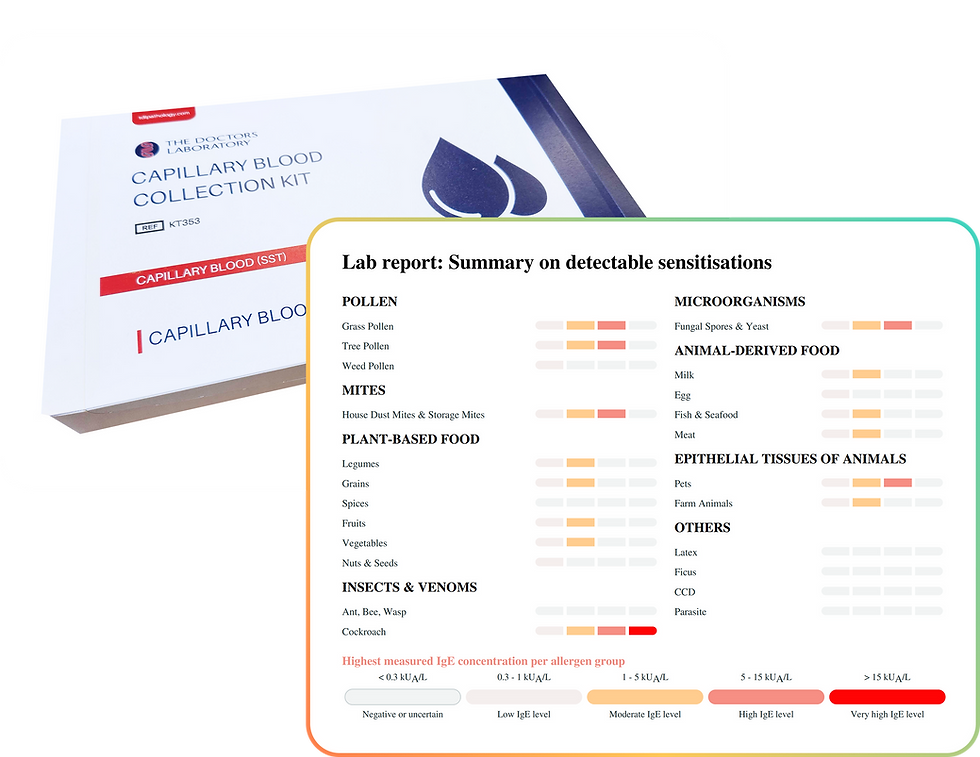From pills to Vaseline: What worked for my son’s hay fever
- AllergyRhino
- Apr 9
- 4 min read
Updated: 19 hours ago
📖 Original article by GP Dr Ellie Cannon, published in the Mail on Sunday (March 2025):
Every spring, my surgery fills up with the same question: "What can I do about my hay fever?"
But this year, the question hit closer to home — it came from my 18-year-old son, Jude.

He’s battled hay fever since primary school, but things got significantly worse in secondary. Exams, social events, sleep — all impacted by streaming eyes, relentless sneezing, and that maddening, itchy throat.
As both his GP and his mum, I’ve seen first-hand just how debilitating hay fever can be — and how often it’s dismissed as just a “bit of a sniffle.”
Here’s what we tried, what worked, and what I now recommend to many of my patients going through the same struggle.
💊 First line of defence: over-the-counter meds
Jude started with the basics, just like most patients do:
Antihistamines (cetirizine and fexofenadine): these block histamine, the chemical behind the allergy symptoms.
Steroid nasal sprays like Beconase and Pirinase: they reduce swelling in the nasal passages and ease congestion.
They helped — but only up to a point. As his A-levels approached and his symptoms became harder to control, we needed something more targeted.
🧬 A deeper look: allergy testing and diagnosis
We booked Jude in with an allergist who carried out blood tests. The results showed:
He was highly allergic to tree and grass pollen
He had no reactions to dust, food, or pets
This was crucial. Knowing the specific pollens allowed us to time his treatment better — and explore long-term options.
💡 Tip: If you're unsure what's triggering your hay fever, consider getting tested privately. It costs around £150 but can save you years of guesswork.
🌱 The turning point: immunotherapy
After years of symptom management, we decided to try immunotherapy — a treatment that doesn’t just mask symptoms but retrains the immune system itself.
How it works:
Daily tablets (like Grazax) containing tiny amounts of pollen
Taken over 3 years
Designed to desensitise the immune system so it no longer overreacts
Jude started last summer. The first tablet had to be taken under supervision in case of a reaction. It made his tongue tingle slightly — but that was it. He’s been on it ever since with no issues.
We’re still early in the journey, but if his symptoms are even half as bad this summer, it’ll be a huge win. Less need for eye drops, fewer tablets, better sleep, and better concentration.
💡 Tip: Immunotherapy is available on the NHS but often comes with long wait times. Speak to your GP early if you think you’re a candidate.
🕒 When you take your meds matters more than you think
One of the biggest mistakes people make? Starting treatment too late.
Steroid sprays take a few days to kick in
Antihistamines work best when taken before symptoms start
If you wait until you’re sneezing — it’s already too late.
Jude now starts his meds at least 2 weeks before peak season hits. For grass pollen sufferers, that’s late May to early June.
💡 Tip: Take antihistamines consistently, not just when symptoms flare. Some people need them twice or even three times a day.
👃 Nasal spray technique: yes, there’s a right way
I was shocked to realise Jude — like many of my patients — wasn’t using his spray properly.Done wrong, it barely works and can cause nosebleeds or soreness.
Here's the correct way:
Blow your nose first
Tip your nose down towards your toes
Use the opposite hand for each nostril (right hand for left nostril, etc.)
Aim the spray outward, not toward the nasal septum
Breathe in gently through the nose, then out through the mouth
💡 Tip: Don't sniff hard. You’ll swallow the medicine, making it less effective.
🧴 The simplest solution? Vaseline.
When everything else seems to fall short, one of the best tricks we found was Vaseline.

A light smear around the nostrils can trap pollen before it enters the body.
Other practical tips that helped Jude:
Keep windows shut during high pollen days
Shower and wash hair after being outside
Use wraparound sunglasses to keep pollen out of eyes
Use cold compresses and eye drops to calm irritation
🩺 So, what actually worked for hay fever?
For Jude, a combination of treatments made the biggest difference:
✅ Daily antihistamines
✅ Starting sprays early
✅ Immunotherapy (in progress)
✅ Proper spray technique
✅ Pollen-avoidance strategies
✅ Vaseline!
It’s not about one miracle cure — it’s about stacking smart habits and treatments. And while hay fever may never go away entirely, it no longer has to control your summer.
Considering long-term options?
If your allergies get worse every year, or you're tired of relying on daily tablets, you might be a candidate for SLIT (sublingual immunotherapy). It’s a once-daily tablet that helps retrain your immune system to become less reactive to pollen over time. Many people find their symptoms significantly reduced within the first year, with long-term benefits that can last even after treatment ends.
Curious about what’s causing your symptoms? This comprehensive allergy blood test screens for +295 allergens, including tree pollen, grass and weed pollen, mites, cat and dog, fur, insect venoms, moulds, yeasts, food and latex, helping you pinpoint triggers and find long-term relief.

Comments